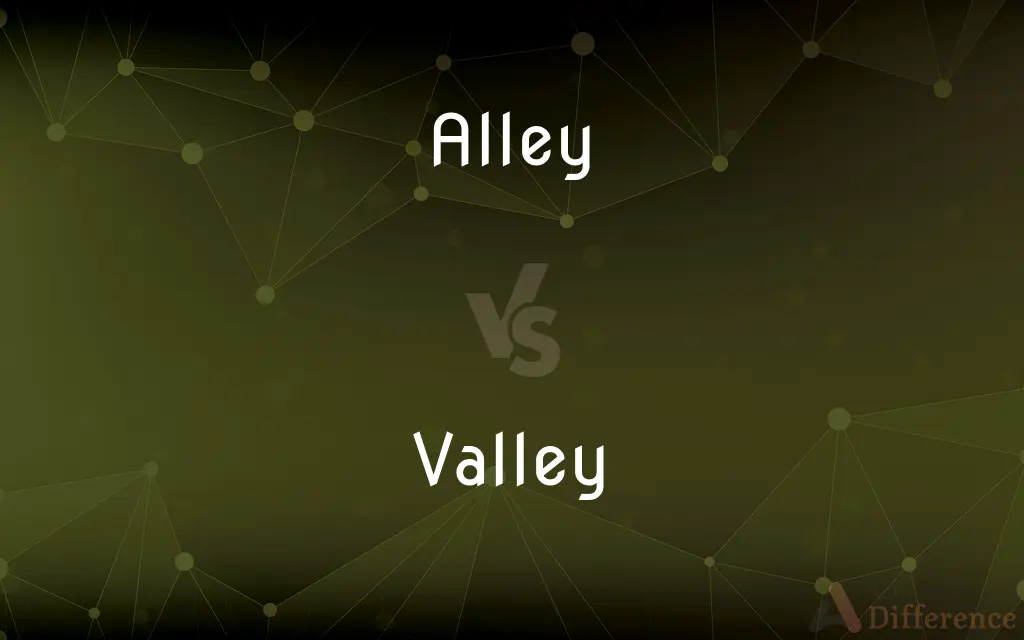Alley vs. Valley — What's the Difference?
By Tayyaba Rehman & Urooj Arif — Updated on March 29, 2024
An alley is a narrow passageway between or behind buildings, while a valley is a low area between hills or mountains, often with a river running through it.

Difference Between Alley and Valley
Table of Contents
ADVERTISEMENT
Key Differences
An alley, often found in urban environments, is a narrow path or street between or behind buildings, providing access or a shortcut. On the other hand, a valley is a natural geographical feature, a low area surrounded by higher land, usually mountains or hills, and often containing a watercourse.
Alleys serve functional urban purposes, such as pedestrian routes or spaces for utility services and garbage collection. Valleys, in contrast, are significant in shaping the earth’s landscape, affecting weather patterns, and providing habitats for diverse ecosystems.
While alleys are human-made structures designed to optimize space in densely built areas, valleys are formed by geological processes, such as erosion by rivers or glacial activity, over millions of years. This fundamental difference highlights the contrast between urban planning and natural landforms.
In literature and culture, alleys often symbolize mystery or danger, used as settings for secretive or suspenseful activities. Valleys, however, are depicted as serene, fertile places or, conversely, as challenges to be overcome, reflecting their natural beauty and the diversity of life they support.
Despite their differences, both alleys and valleys play crucial roles in their respective contexts. Alleys enhance urban functionality and can contribute to the character of cityscapes, while valleys are key to understanding geological history and biodiversity.
ADVERTISEMENT
Comparison Chart
Definition
A narrow passageway between or behind buildings
A low area between hills or mountains, often with a river
Environment
Urban
Natural
Function
Access, service, or shortcut in built environments
Ecosystem habitat, weather patterns influence
Formation
Human-made
Formed by geological processes
Cultural Symbolism
Mystery, danger, urban secrecy
Serenity, fertility, natural beauty, challenges
Compare with Definitions
Alley
Used for utility access or as a pedestrian path.
The restaurant's back door opened to a service alley.
Valley
A low area between hills or mountains, often containing a river.
The valley was lush and green, with a river winding through it.
Alley
Can be a setting in urban narratives.
The detective chased the suspect through the dark alleys.
Valley
Formed by geological processes like erosion.
The glacier carved out a stunning valley over millennia.
Alley
A narrow street between or behind buildings.
The graffiti artist found his canvas in a hidden alley.
Valley
Depicted as serene or fertile in culture.
Poets often muse about the peaceful life in the valley.
Alley
Symbolizes urban secrecy or danger in literature.
The alley was a common meeting place for the clandestine group.
Valley
Important for agriculture and human settlements.
Ancient civilizations thrived in river valleys due to fertile land.
Alley
Enhances urban space utilization.
Alleys in the city are often used for garbage collection and deliveries.
Valley
A habitat for diverse ecosystems.
The valley supports a wide range of flora and fauna.
Alley
An alley or alleyway is a narrow lane, path, or passageway, often reserved for pedestrians, which usually runs between, behind, or within buildings in the older parts of towns and cities. It is also a rear access or service road (back lane), or a path, walk, or avenue (French allée) in a park or garden.A covered alley or passageway, often with shops, may be called an arcade.
Valley
A valley is an elongated low area often running between hills or mountains, which will typically contain a river or stream running from one end to the other. Most valleys are formed by erosion of the land surface by rivers or streams over a very long period of time.
Alley
A narrow street or passageway between or behind city buildings.
Valley
A low area of land between hills or mountains, typically with a river or stream flowing through it
The valley floor
The Thames Valley
Alley
A path between flower beds or trees in a garden or park.
Valley
An internal angle formed by the intersecting planes of a roof, or by the slope of a roof and a wall.
Alley
A straight narrow course or track, especially a bowling alley.
Valley
An elongated lowland between ranges of mountains, hills, or other uplands, often having a river or stream running along the bottom.
Alley
Either of the parallel lanes at the sides of a tennis court, which widen the inbounds area for doubles play.
Valley
An extensive area of land drained or irrigated by a river system.
Alley
A large playing marble, often used as the shooter.
Valley
A depression or hollow resembling or suggesting a valley, as the point at which the two slopes of a roof meet.
Alley
A narrow street or passageway, especially one through the middle of a block giving access to the rear of lots of buildings.
The parking lot to my friend's apartment building is in the alley.
Valley
An elongated depression cast between hills or mountains, often garnished with a river flowing through it.
Alley
(baseball) The area between the outfielders.
He hit one deep into the alley.
Valley
An area which drains itself into a river.
Alley
(bowling) An establishment where bowling is played.
Valley
Any structure resembling one, e.g. the interior angle formed by the intersection of two sloping roof planes.
Alley
(bowling) An elongated wooden strip of floor along which a bowling ball is rolled.
Valley
To form the shape of a valley.
Alley
(tennis) The extra area between the sidelines or tramlines on a tennis court that is used for doubles matches.
Valley
The place of meeting of two slopes of a roof, which have their plates running in different directions, and form on the plan a reëntrant angle.
Alley
A walk or passage in a garden or park, bordered by rows of trees or bushes.
Valley
A long depression in the surface of the land that usually contains a river
Alley
A passageway between rows of pews in a church.
Alley
(perspective drawing) Any passage having the entrance represented as wider than the exit, so as to give the appearance of length.
Alley
The space between two rows of compositors' stands in a printing office.
Alley
A glass marble or taw.
Alley
A narrow passage; especially a walk or passage in a garden or park, bordered by rows of trees or bushes; a bordered way.
I know each lane and every alley green.
Alley
A narrow passage or way in a city, as distinct from a public street.
Alley
A passageway between rows of pews in a church.
Alley
Any passage having the entrance represented as wider than the exit, so as to give the appearance of length.
Alley
The space between two rows of compositors' stands in a printing office.
Alley
A choice taw or marble.
Alley
A narrow street with walls on both sides
Alley
A lane down which a bowling ball is rolled toward pins
Common Curiosities
Can valleys be found in urban areas?
While valleys are natural formations, urban development can occur in valleys, blending city structures with the natural landscape.
Are all alleys narrow and dark?
Not necessarily. While alleys are typically narrow, their appearance can vary widely based on maintenance, lighting, and use.
What types of valleys are there?
Valleys can be classified by their formation and shape, such as river valleys, glacial valleys, and rift valleys.
Why are valleys important to ecosystems?
Valleys often have rivers or streams, creating rich, fertile lands that support diverse plants and wildlife, making them crucial for biodiversity.
How do alleys benefit urban areas?
Alleys can improve city functionality by providing space for utilities, waste collection, and alternative pedestrian pathways, reducing clutter on main streets.
Do alleys have a historical significance?
Yes, alleys have been an integral part of city layouts for centuries, reflecting historical urban design practices and the evolution of cities.
Can valleys influence climate?
Yes, valleys can affect local climate patterns, often being cooler and having different weather conditions compared to surrounding higher ground.
What differentiates an alley from a street?
An alley is narrower than a street and is often not the main thoroughfare, serving more as a secondary access or service path.
Can the presence of a valley affect human settlement?
Absolutely, valleys have been preferred sites for human settlement due to their fertile land and water resources.
How are alleys and valleys represented in art?
Alleys often appear in urban art and film noir as mysterious or gritty locations, while valleys are depicted in landscapes as idyllic or challenging terrains.
Is alley maintenance important in cities?
Proper maintenance is crucial for keeping alleys safe, clean, and functional, affecting the overall quality of urban living.
What role do alleys play in urban planning?
In urban planning, alleys help manage space efficiently, providing necessary services and pedestrian routes without encroaching on main urban spaces.
How are valleys formed?
Valleys form through geological processes such as erosion by water or ice and tectonic activity, shaping the landscape over time.
How do cultural perceptions of alleys and valleys differ?
Cultural perceptions vary; alleys might be seen as places of intrigue or danger, while valleys are often viewed as beautiful, peaceful, or agriculturally valuable.
What environmental concerns are associated with valleys?
Valleys can be vulnerable to environmental issues like deforestation, pollution, and climate change, impacting their ecosystems.
Share Your Discovery

Previous Comparison
Hosanna vs. Hallelujah
Next Comparison
Urn vs. VaseAuthor Spotlight
Written by
Tayyaba RehmanTayyaba Rehman is a distinguished writer, currently serving as a primary contributor to askdifference.com. As a researcher in semantics and etymology, Tayyaba's passion for the complexity of languages and their distinctions has found a perfect home on the platform. Tayyaba delves into the intricacies of language, distinguishing between commonly confused words and phrases, thereby providing clarity for readers worldwide.
Co-written by
Urooj ArifUrooj is a skilled content writer at Ask Difference, known for her exceptional ability to simplify complex topics into engaging and informative content. With a passion for research and a flair for clear, concise writing, she consistently delivers articles that resonate with our diverse audience.
















































